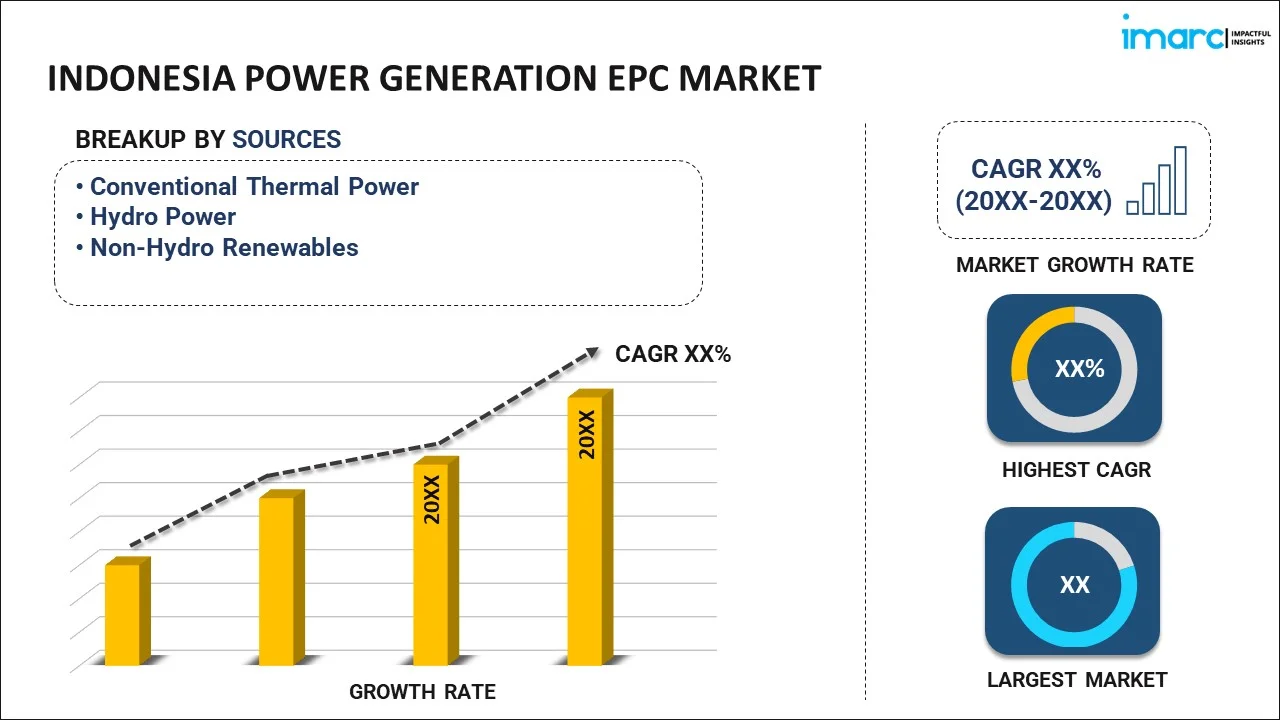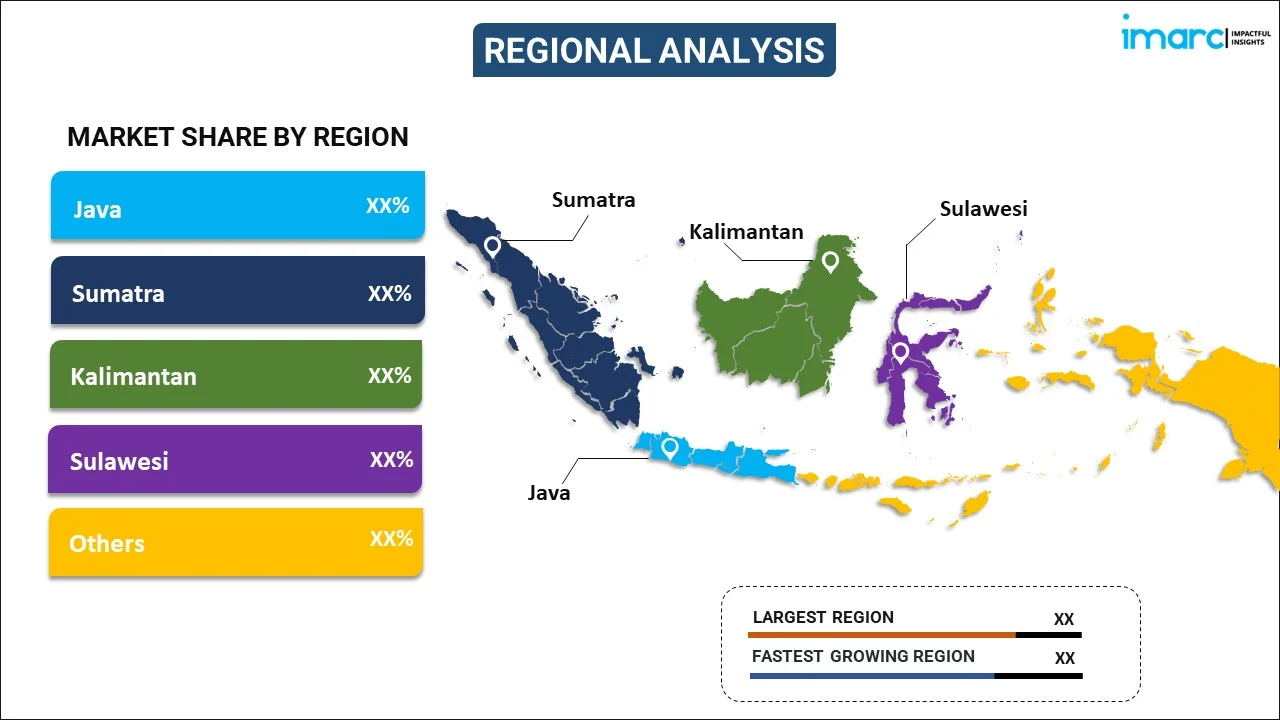
Indonesia Power Generation EPC Market Report by Source (Conventional Thermal Power, Hydro Power, Non-Hydro Renewables), and Region 2024-2032
Market Overview:
Indonesia power generation EPC market size is projected to exhibit a growth rate (CAGR) of 2.43% during 2024-2032. The expanding infrastructural development, emerging trends toward energy diversification, increasing foreign direct investments (FDI), government-backed projects, and the rising energy demand represent some of the key factors driving the market.
|
Report Attribute
|
Key Statistics
|
|---|---|
|
Base Year
|
2023 |
|
Forecast Years
|
2024-2032
|
|
Historical Years
|
2018-2023
|
| Market Growth Rate (2024-2032) | 2.43% |
Power generation engineering, procurement, and construction (EPC) is a comprehensive approach to developing power generation projects. It encompasses the entire lifecycle of a power generation project, from its conceptualization to its final operational stage. EPC contractors are responsible for designing, procuring all necessary equipment and materials, and constructing the power generation facility, ensuring that it meets the required technical specifications and quality standards. This approach is widely utilized in various power generation sectors, including thermal, renewable, nuclear, and hydroelectric power plants. Power generation EPC projects consist of numerous phases, such as initial feasibility studies, detailed engineering and design, the selection of appropriate technologies and suppliers, procurement and logistics, construction, and commissioning. Power generation EPC minimizes risks, reduces development time, and ensures that the completed power generation facility operates efficiently and safely. Consequently, it plays an essential role in meeting the world's growing energy demands and transitioning to more sustainable and environmentally friendly power generation solutions.
Indonesia Power Generation EPC Market Trends:
The Indonesia power generation EPC market is experiencing robust growth due to the country's surging population and urbanization rates fueling the demand for electricity. Besides this, the government's strong commitment to achieving energy self-sufficiency and diversifying the energy mix has propelled investments in various energy sources, including coal, natural gas, renewable energy, and nuclear power, impelling the adoption of power generation EPC. Moreover, the growing emphasis on environmental sustainability and the reduction of greenhouse gas (GHG) emissions has spurred investments in renewable energy projects, thereby creating a favorable outlook for market expansion. In confluence with this, improving access to financing options and foreign investments, combined with a favorable regulatory environment, is making it easier to secure funding for large-scale power generation projects, boosting the EPC market's growth. Concurrently, the aging infrastructure of existing power plants necessitates rehabilitation, modernization, and repowering is aiding in market expansion. In confluence with this, Indonesia's geographic diversity and complex terrain are driving the need for specialized EPC off-grid and microgrid solutions for power projects in challenging locations, such as remote islands and mountainous areas, thereby contributing to the market growth. Additionally, the country's vulnerability to natural disasters like earthquakes and volcanic eruptions emphasizes the need for resilient, disaster-resistant power infrastructure, which is furthering the demand for EPC services. Furthermore, significant technological advancements and innovations in power generation and distribution, including smart grids and digitalization, are pushing the EPC sector towards more sophisticated and efficient solutions, bolstering market expansion. Apart from this, the burgeoning global interest in energy transition and sustainability projects, combined with Indonesia's position as an emerging market, is attracting international EPC firms looking to tap into the country's expanding power generation sector, which, in turn, is propelling the market toward growth.
Indonesia Power Generation EPC Market Segmentation:
IMARC Group provides an analysis of the key trends in each segment of the market, along with forecasts at the country level for 2024-2032. Our report has categorized the market based on source.
Source Insights:

- Conventional Thermal Power
- Oil
- Coal
- Natural Gas
- Hydro Power
- Non-Hydro Renewables
- Geothermal
- Bioenergy
The report has provided a detailed breakup and analysis of the market based on the source. This includes conventional thermal power (oil, coal, and natural gas), hydro power, and non-hydro renewables (geothermal and bioenergy).
Regional Insights:

- Java
- Sumatra
- Kalimantan
- Sulawesi
- Others
The report has also provided a comprehensive analysis of all the major regional markets, which include Java, Sumatra, Kalimantan, Sulawesi, and others.
Competitive Landscape:
The market research report has also provided a comprehensive analysis of the competitive landscape in the market. Competitive analysis such as market structure, key player positioning, top winning strategies, competitive dashboard, and company evaluation quadrant has been covered in the report. Also, detailed profiles of all major companies have been provided.
Indonesia Power Generation EPC Market Report Coverage:
| Report Features | Details |
|---|---|
| Base Year of the Analysis | 2023 |
| Historical Period | 2018-2023 |
| Forecast Period | 2024-2032 |
| Units | US$ Million |
| Scope of the Report | Exploration of Historical and Forecast Trends, Industry Catalysts and Challenges, Segment-Wise Historical and Predictive Market Assessment:
|
| Sources Covered |
|
| Regions Covered | Java, Sumatra, Kalimantan, Sulawesi, Others |
| Customization Scope | 10% Free Customization |
| Report Price and Purchase Option | Single User License: US$ 3699 Five User License: US$ 4699 Corporate License: US$ 5699 |
| Post-Sale Analyst Support | 10-12 Weeks |
| Delivery Format | PDF and Excel through Email (We can also provide the editable version of the report in PPT/Word format on special request) |
Key Questions Answered in This Report:
- How has the Indonesia power generation EPC market performed so far and how will it perform in the coming years?
- What has been the impact of COVID-19 on the Indonesia power generation EPC market?
- What is the breakup of the Indonesia power generation EPC market on the basis of source?
- What are the various stages in the value chain of the Indonesia power generation EPC market?
- What are the key driving factors and challenges in the Indonesia power generation EPC?
- What is the structure of the Indonesia power generation EPC market and who are the key players?
- What is the degree of competition in the Indonesia power generation EPC market?
Key Benefits for Stakeholders:
- IMARC’s industry report offers a comprehensive quantitative analysis of various market segments, historical and current market trends, market forecasts, and dynamics of the Indonesia power generation EPC market from 2018-2032.
- The research report provides the latest information on the market drivers, challenges, and opportunities in the Indonesia power generation EPC market.
- Porter's five forces analysis assist stakeholders in assessing the impact of new entrants, competitive rivalry, supplier power, buyer power, and the threat of substitution. It helps stakeholders to analyze the level of competition within the Indonesia power generation EPC industry and its attractiveness.
- Competitive landscape allows stakeholders to understand their competitive environment and provides an insight into the current positions of key players in the market.
Need more help?
- Speak to our experienced analysts for insights on the current market scenarios.
- Include additional segments and countries to customize the report as per your requirement.
- Gain an unparalleled competitive advantage in your domain by understanding how to utilize the report and positively impacting your operations and revenue.
- For further assistance, please connect with our analysts.
 Inquire Before Buying
Inquire Before Buying
 Speak to an Analyst
Speak to an Analyst
 Request Brochure
Request Brochure
 Request Customization
Request Customization




.webp)




.webp)












